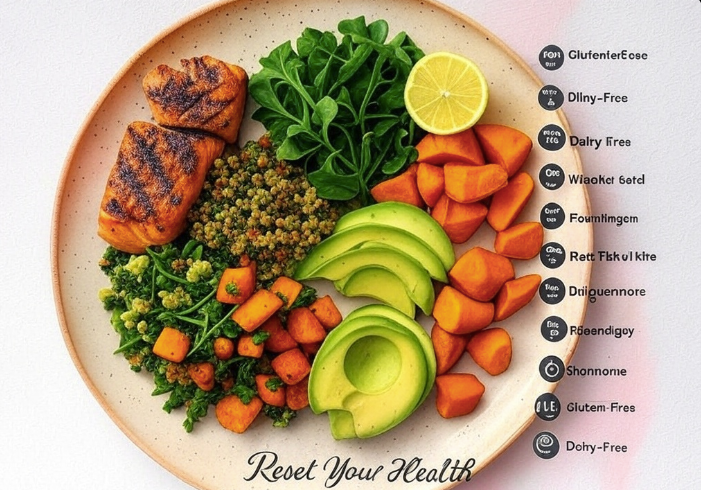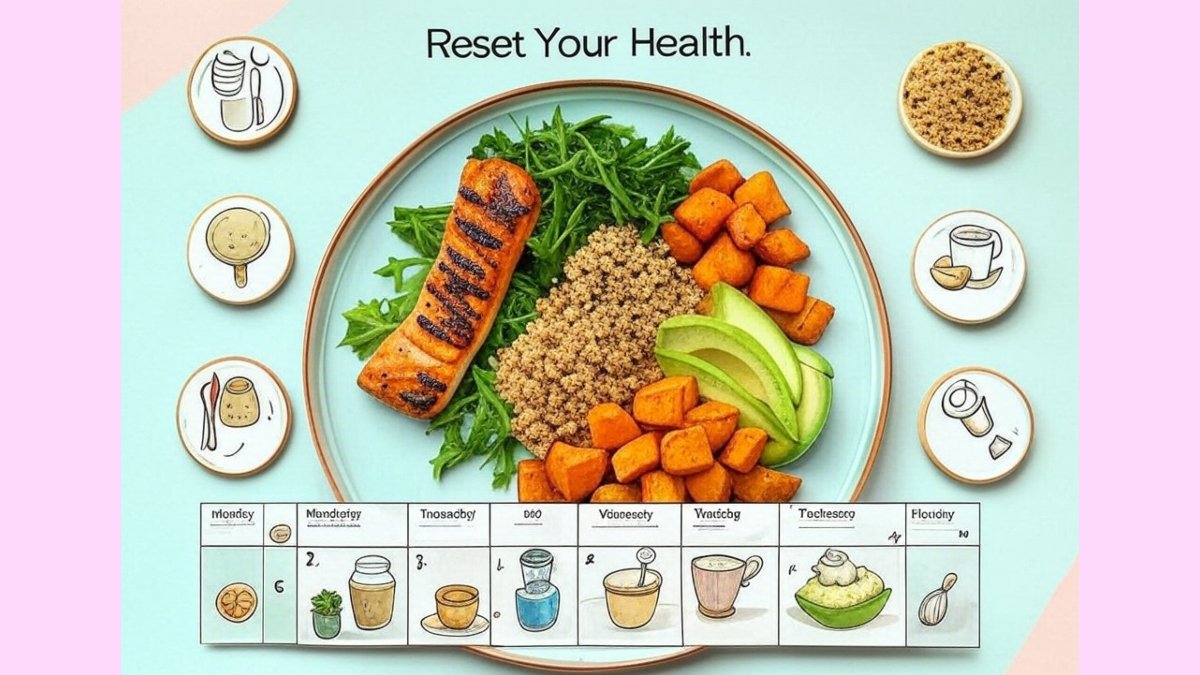An Elimination Diet Meal Plan involves eliminating certain foods and then reintroducing them one at a time may be a useful tool for identifying food intolerances, hypersensitivities, or sensitivities. It improves digestion, lessens irritability, and identifies problematic meals that may trigger adverse effects, including weakness, bloating, skin problems, or headaches.
The two phases of an end-count calorie count are disposal and reintroduction, in which you temporarily eliminate popular trigger meals and then progressively return them to observe reactions. Whole, less processed foods such as leafy greens, lean proteins, gluten-free cereals, and low-histamine natural goods are included in a seven-day test plan.
Table of Contents
What Is an Elimination Diet Meal Plan?
A short-term diet plan called an end slim down may be used to help people identify food sensitivities and intolerances. There are two crucial phases to it:
- Reintroduction Stage: Monitor your body’s response as you gradually reintroduce one food at a time.
- Disposal Stage: For two to four weeks, avoid typical foods that cause allergies or provoke reactions.
Who Should Take It Into Account?
- People who have stomach problems (gas, bloating, IBS)
- People who suffer from dermatitis, acne, or persistent skin disorders
- Individuals with a dysfunctional immune system
- Anyone experiencing headaches, weakness, or brain fog?
Note: Constantly advise a registered dietician or other healthcare professional to stop eating at some point recently.
Benefits of a Disposal Eat less Feast Arrange
- Recognizes trigger nourishments
- Decreases aggravation
- Makes strides in vitality levels
- Bolsters skin and intestinal wellbeing
- Upgrades mental clarity
Common Nourishments to Dispose of
Here’s a table of the most common nourishment groups dispensed with:
Food Categories Reference
| Food Category | Examples |
|---|---|
| Dairy | Milk, cheese, yogurt, butter |
| Gluten | Wheat, barley, rye, spelt |
| Soy | Tofu, soy milk, soy sauce |
| Eggs | Whole eggs, baked goods with eggs |
| Corn | Corn syrup, cornmeal, popcorn |
| Nuts & Seeds | Almonds, peanuts, sunflower seeds |
| Nightshades | Tomatoes, eggplants, peppers, potatoes |
| Caffeine & Alcohol | Coffee, energy drinks, wine, beer |
| Processed Sugars | Candy, pastries, soda |
| Artificial Additives | Preservatives, flavorings, MSG |
What Can You Eat on a Disposal Count calories?
Center on anti-inflammatory, nutrient-dense, and whole foods:
- Vegetables: Verdant greens, carrots, broccoli, zucchini
- Proteins: Natural chicken, turkey, wild-caught angel
- Gluten-Free Grains: Quinoa, brown rice, millet
- Natural products: Apples, pears, berries (low-FODMAP choices)
- Solid Fats: Avocados, olive oil, and coconut oil
- Refreshments: Water, home-grown teas, bone broth
7-Day Disposal Count calories Feast Arrange

Here’s a beginner-friendly end-of-calorie-count supper arrangement:
Day 1
- Breakfast: Quinoa porridge with blueberries and coconut milk
- Lunch: Flame broiled chicken with kale, a serving of mixed greens & olive oil vinaigrette
- Supper: Prepared salmon with simmered carrots and sweet potatoes
- Nibble: Cut a pear with sunflower seed butter
Day 2
- Breakfast: Smoothie (spinach, green apple, chia, coconut water)
- Lunch: Turkey lettuce wraps with cucumber and avocado
- Supper: Stir-fried zucchini noodles with ground turkey
- Nibble: Heated apple with cinnamon
Day 3
- Breakfast: Brown rice cakes with squashed avocado
- Lunch: Lentil soup with blended greens
- Supper: Barbecued cod with steamed broccoli and brown rice
- Nibble: Cucumber slices with hummus
(Proceed with design for Days 4–7)
Read Also 7 Day GERD Diet Plan for Women: Soothe Corrosive Reflux Normally
Reintroduction Stage: How to Reintroduce Nourishments
After the end stage, reintroduce one nourishment at a time, each 3–4 days, while watching side effects.
Step-by-Step Reintroduction Case:
- Day 1: Reintroduce dairy (e.g., yogurt). Screen indications.
- Days 2–3: Dodge dairy. Observe for postponed responses.
- Day 4: Present gluten (e.g., whole wheat toast).
- Rehash for other nourishment groups.
Tip: Keep a nourishment and indication diary during this stage.

Tips for an Effective Disposal: Eat less
- Arrange dinners ahead of time
- Cook at domestic to cover up fixings
- Studied names for allergens and added substances
- Drink a bounty of water
- Get back from a nutritionist
Common Botches to Maintain a Strategic Distance from
- Reintroducing numerous foods at once
- Not keeping a side effect journal
- Stopping as well early
- Eating “elimination-safe” snacks with added substances
Read Also The Menopause Diet 5-Day Plan to Lose Weight Naturally and Safely
(FAQ)
How long ought an end elimination diet last?
As a rule, 2–4 weeks for the end stage and 4–6 weeks for reintroduction.
Can I lose weight on an elimination diet?
Yes, weight loss may occur due to reduced processed food and inflammation.
Is it safe for children or pregnant women?
Consult a healthcare professional first; not recommended without supervision.
Last Contemplations: Is an End Eat less Right for You?
An Elimination Diet Meal Plan can be a capable device to reset your body, identify covered food sensitivities, and move forward generally health. When done legitimately, it gives you an understanding of how your body responds to distinctive foods, so you’ll be able to eat more intelligently and feel way better each day.






I appreciate how this post simplifies the elimination diet process — breaking it into elimination and reintroduction makes it feel much more doable. I’ve found tracking symptoms during reintroduction is crucial, especially for less obvious reactions like fatigue or mood changes.
This post is a great reminder of how connected our diet is to overall wellness. I’ve always wondered, during the reintroduction phase, how long should you typically wait between adding different foods back? It seems like timing would really impact how accurately you can spot food sensitivities.
You Are Right.
I appreciate how clearly you broke down the elimination diet into its two core phases—elimination and reintroduction. It’s helpful to see an emphasis on minimally processed foods and low-histamine fruits during the test period, especially for those new to the process. I’ve found tracking symptoms daily during reintroduction also makes it easier to spot patterns—might be worth adding that tip for readers!
Thanks
It’s interesting how symptoms like fatigue or skin issues might be connected to hidden food sensitivities. Paying close attention during the reintroduction phase seems like the key to actually uncovering those triggers.